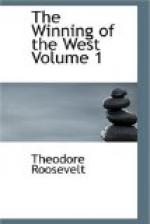When the party left this lick they followed a buffalo trail, beaten out in the forest, “the size of the wagon road leading out of Williamsburg,” then the capital of Virginia. It crossed the Kentucky River at a riffle below where Frankfort now stands. Thence they started homewards across the Cumberland Mountains, and suffered terribly while making their way through the “desolate and voiceless solitudes”; mere wastes of cliffs, crags, caverns, and steep hillsides covered with pine, laurel, and underbrush. Twice they were literally starving and were saved in the nick of time by the killing, on the first occasion, of a big bull elk, on the next, of a small spike buck. At last, sun-scorched and rain-beaten, foot-sore and leg-weary, their thighs torn to pieces by the stout briars,[34] and their feet and hands blistered and scalded, they came out in Powell’s Valley, and followed the well-worn hunter’s trail across it. Thence it was easy to reach home, where the tale of their adventures excited still more the young frontiersmen.
Their troubles were ended for the time being; but in Powell’s Valley they met other wanderers whose toil and peril had just begun. There they encountered the company[35] which Daniel Boon was just leading across the mountains, with the hope of making a permanent settlement in far distant Kentucky.[36] Boon had sold his farm on the Yadkin and all the goods he could not carry with him, and in September, 1773, he started for Kentucky with his wife and his children; five families, and forty men besides, went with him, driving their horses and cattle. It was the first attempt that was made to settle a region separated by long stretches of wilderness from the already inhabited districts; and it was doomed to failure. On approaching the gloomy and forbidding defiles of the Cumberland Mountains the party was attacked by Indians.[37] Six of the men, including Boon’s eldest son, were slain, and the cattle scattered; and though the backwoodsmen rallied and repulsed their assailants, yet they had suffered such loss and damage that they retreated and took up their abode temporarily on the Clinch River.
In the same year Simon Kenton, afterwards famous as a scout and Indian fighter, in company with other hunters, wandered through Kentucky. Kenton, like every one else, was astounded at the beauty and fertility of the land and the innumerable herds of buffalo, elk, and other game that thronged the trampled ground around the licks. One of his companions was taken by the Indians, who burned him alive.




